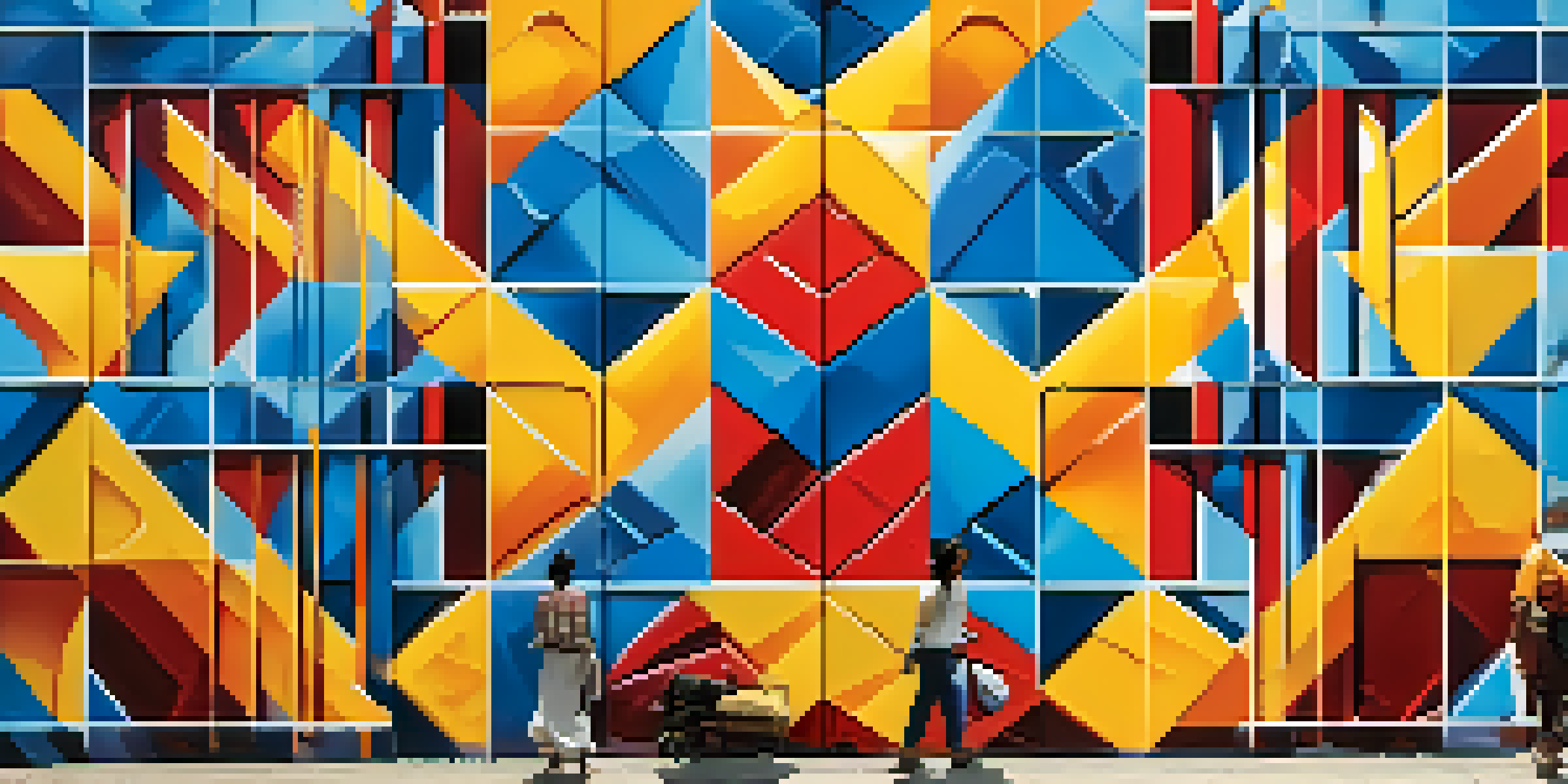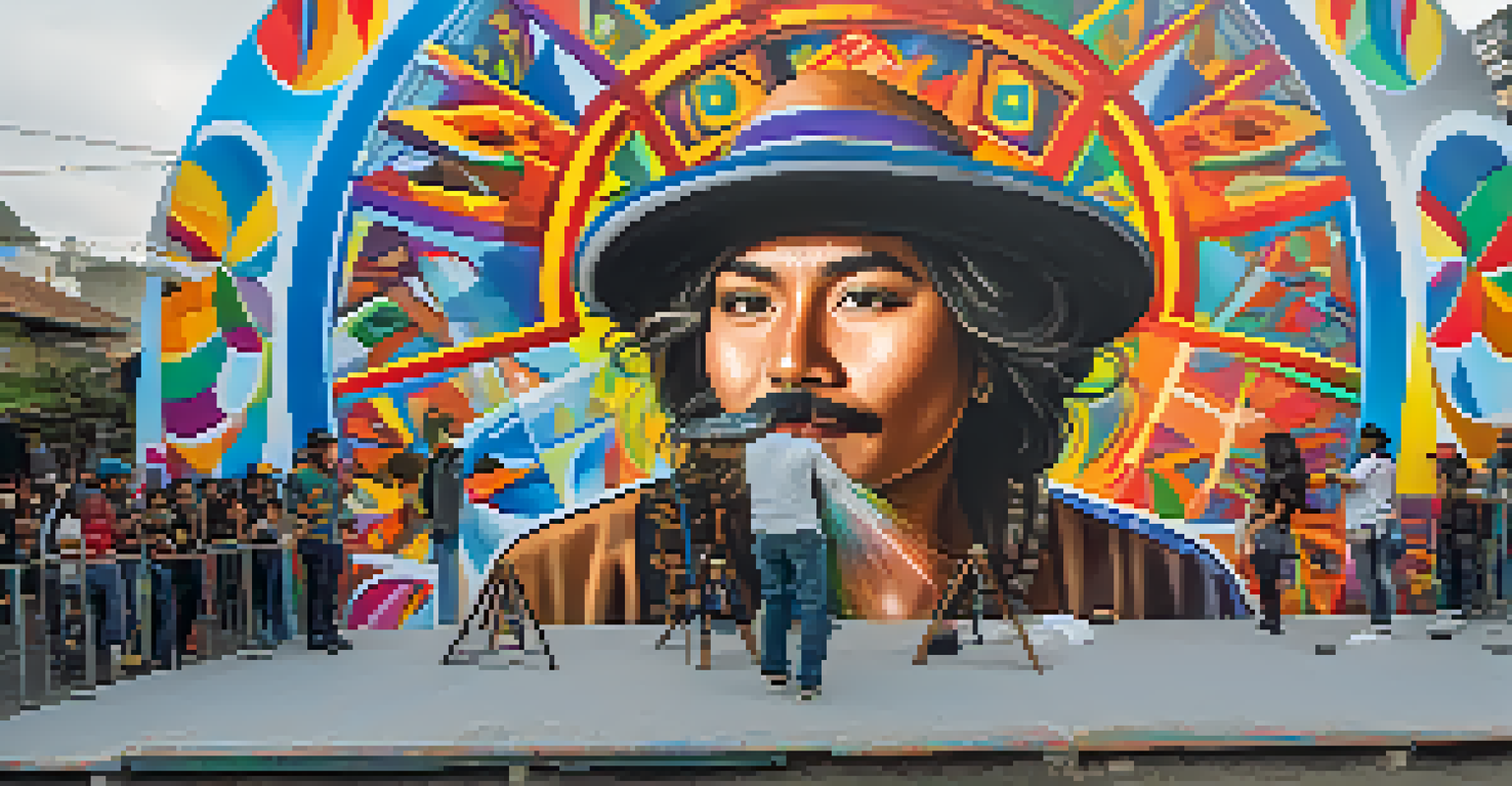Street Art Festivals in Peru: Celebrating Urban Creativity

The Rise of Street Art in Peru: A Colorful Revolution
Street art in Peru has blossomed into a vibrant form of expression, reflecting the country's rich culture and contemporary issues. Artists transform blank walls into canvases, narrating stories that resonate with the community. This rise in popularity has paved the way for annual street art festivals celebrating urban creativity and talent.
Art is the most beautiful of all lies; it is the only way we can express our deepest truths.
These festivals not only showcase local artists but also invite international talent, creating a melting pot of styles and influences. The sense of unity among artists and the audience fosters a collaborative spirit, making these events a true celebration of creativity. The streets become alive with color, music, and performances, drawing in art enthusiasts from all walks of life.
As street art gains recognition in Peru, it challenges societal norms and encourages dialogue on important issues such as identity, politics, and social justice. This cultural phenomenon highlights the power of art as a tool for change, making street art festivals an essential part of Peru's urban landscape.
Exploring the Most Notable Street Art Festivals in Peru
Peru hosts several street art festivals, each with its unique flair and character. One of the most prominent is the 'Meeting of Styles,' which attracts artists from around the globe to collaborate and create stunning murals in cities like Lima. This festival showcases diverse styles, ranging from graffiti to intricate murals, highlighting the rich tapestry of urban creativity.

Another notable event is the 'Festival de Arte Urbano,' which takes place in various locations, transforming public spaces into art galleries. This festival emphasizes community engagement, encouraging local residents to participate in workshops and activities, bridging the gap between artists and the public. It's a fantastic way to discover new talents and appreciate the power of collective creativity.
Street Art Celebrates Peru's Culture
Street art in Peru serves as a vibrant expression of the country's rich cultural heritage and contemporary issues.
Additionally, the 'Mural Festival' in Cusco has gained popularity, celebrating the intersection of ancient culture and modern art. Artists draw inspiration from the city's rich history, creating pieces that resonate with both locals and tourists. These festivals not only beautify urban spaces but also contribute to the cultural identity of Peru.
Key Artists Shaping Peru's Street Art Scene
Among the vibrant street art scene in Peru, several artists stand out for their remarkable contributions. For instance, 'Etnik' is known for his mesmerizing geometric designs that often incorporate elements of Andean culture. His work not only beautifies the streets but also sparks conversations about heritage and identity.
Street art is the voice of the people; it’s a dialogue between the artist and the community.
Similarly, the artist 'Dasic Fernandez' brings a unique flair to the urban landscape with his colorful murals that blend pop culture with traditional themes. His pieces are often characterized by bold colors and dynamic characters, making them instantly recognizable. Dasic's art transcends mere decoration; it invites viewers to engage with the narratives behind each piece.
Lastly, the collective 'Pablo Amaringo' focuses on environmental themes, using their art to raise awareness about ecological issues in Peru. Their murals often depict the beauty of the Amazon rainforest, encouraging communities to take action in preserving their natural heritage. These artists, among many others, are pivotal in shaping the narrative of Peru's street art scene.
The Impact of Street Art on Local Communities
Street art festivals in Peru have a profound impact on local communities, fostering a sense of pride and ownership. When murals adorn the walls of their neighborhoods, residents often feel a deeper connection to their surroundings. The art reflects their stories, struggles, and aspirations, creating a shared cultural narrative.
Moreover, these festivals stimulate local economies by attracting tourists, art lovers, and media attention. Businesses in surrounding areas often benefit from increased foot traffic, creating a win-win situation for both artists and the community. This economic boost can lead to more funding for cultural initiatives and community projects.
Festivals Foster Community Engagement
Street art festivals not only showcase artists but also actively involve local communities, enhancing cultural pride and collaboration.
Additionally, street art acts as a catalyst for social change, encouraging dialogue and awareness around important issues. Many murals address topics such as inequality, environmental concerns, and social justice, inspiring conversations within the community. This engagement not only empowers individuals but also strengthens the fabric of society.
How Street Art Festivals Promote Cultural Exchange
One of the most exciting aspects of street art festivals in Peru is their role in promoting cultural exchange. By inviting international artists, these events create a platform for the sharing of ideas, techniques, and styles. This exchange enriches the local art scene and introduces fresh perspectives that can inspire budding artists.
Collaborative projects during these festivals often result in stunning artworks that blend diverse influences. Artists from different backgrounds come together to create murals that tell a story of unity and creativity. This collaboration not only enhances the visual landscape but also fosters friendships and partnerships across borders.
Furthermore, cultural exchange extends beyond the art itself; it encompasses music, dance, and culinary experiences. Festivals often feature live performances and workshops, allowing attendees to immerse themselves in various cultural expressions. This celebration of diversity strengthens the sense of community and highlights the universal language of art.
Challenges Facing Street Artists in Peru
Despite the vibrancy of street art festivals, artists in Peru face several challenges. One major issue is obtaining permission to create murals, as many artists encounter bureaucratic hurdles when seeking approval from local authorities. This can lead to frustration and limit creative expression in public spaces.
Additionally, there is often a stigma attached to street art, with some viewing it as vandalism rather than a legitimate form of art. This perception can hinder artists' opportunities for recognition and support. Overcoming these barriers requires a collective effort from artists, communities, and policymakers to foster a more supportive environment for urban creativity.
Challenges for Street Artists Persist
Despite its growth, street artists in Peru face obstacles such as bureaucratic hurdles, stigma, and financial constraints.
Finally, financial constraints can also pose a challenge for many street artists. While festivals provide some opportunities, many artists struggle to secure funding for their projects. Grants and sponsorships can help address these issues, but there remains a need for greater investment in the arts to ensure that street art continues to thrive in Peru.
The Future of Street Art Festivals in Peru
Looking ahead, the future of street art festivals in Peru appears promising, with growing interest and participation from both artists and audiences. As awareness of street art's cultural significance increases, more communities are likely to embrace these events as a means of celebrating creativity and identity. This shift could lead to even more festivals and collaborations across the country.
Furthermore, the integration of technology and social media is transforming how street art is perceived and shared. Artists can now reach wider audiences through online platforms, showcasing their work to people around the world. This digital presence not only elevates their profiles but also encourages global conversations about urban art.

Ultimately, the continued growth of street art festivals in Peru will depend on community support and investment in the arts. As more people recognize the value of street art as a powerful form of expression, we can expect to see an even more dynamic and diverse urban art scene that reflects the richness of Peruvian culture.